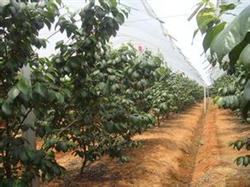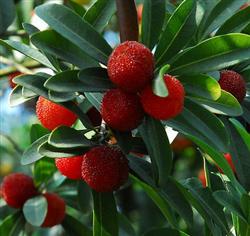Soil Management and Protection measures in Cherry Orchard

Cherry tree is a shallow root fruit tree, not drought resistance, waterlogging tolerance, not wind resistance, therefore, cherry tree to soil management requirements are higher. Ridge cultivation planting cherry trees on the ridge, ridge drainage, is one of the most effective measures to prevent waterlogging, drought; generally ridge width 150~200 cm, ridge height 20~25 cm, and orchard edge drainage branch ditch and drainage ditch communication, in order to timely discharge field ponding. Cherry roots are shallow. After planting, a mound of about 30cm is cultivated at the base of the trunk, which can enhance the fixation of the tree body, increase the absorption area of the root system, and also have the function of drought resistance and moisture preservation; soil cultivation is generally carried out in early spring, and the mound is removed in autumn to treat diseases in time; the top of the mound shall be closely connected with the trunk to prevent rainwater from flowing into the trunk and causing waterlogging. Deep ploughing and hole expansion should be carried out from autumn of the first to second year after planting, so as to facilitate root expansion; deep ploughing and hole expansion can be carried out all year round, but the best time is autumn (September to October) every year; because the temperature and soil temperature are relatively high at this time, the broken roots are easy to heal, and the number of new roots is the largest in spring of the next year, which can enhance nutrient absorption; base fertilizer can be applied in autumn in combination with hole expansion. If the garden soil is clay, in addition to applying crop straw and animal manure, sand should also be mixed to improve soil permeability. In the first few years after planting, from the edge of the planting hole, expand outward every year or every other year, dig a circular ditch about 50 cm wide and 60 cm deep, fill in soil and farm manure, and gradually expand until the deep ditch between the two trees is connected; orchard hole expansion should be combined with autumn base fertilizer, and the farm manure and the ditch soil or sand for soil improvement should be mixed and filled into the ditch, and then irrigated thoroughly; when expanding the hole, do not damage too many thick roots; When the soil is barren, more livestock manure or crop straw should be applied to increase the organic matter content of the soil; in about 2 to 4 years, the whole garden should be expanded once. Cultivate loose soil is usually carried out after irrigation and rain; after each irrigation, cultivate loose soil, on the one hand, it can keep water and prevent soil hardening, on the other hand, it can eliminate weeds; after entering the rainy season, the number of rains increases, weeds grow faster, and it is necessary to hoe several times, with a depth of about 5 cm, to prevent damage to thick roots. During the intercropping period of young trees in orchards, economic crops can be properly intercropped between rows; crops suitable for intercropping should be short plants, short growth periods, less water absorption, less nutrients, a large amount of fertilizer and water requirements staggered with fruit trees, shallow roots, fewer diseases and insect pests, no same diseases and insect pests as cherries or cannot be intermediate hosts of main diseases and insect pests of cherries; beans, melons and vegetables, medicinal plants, green manure, etc. are good, and wheat, corn, sweet potato, etc. are not suitable for intercropping; Intercropping to leave enough tree tray, intercropping time according to planting density and tree growth, in order not to affect the growth of trees for the principle, generally 1~2 years. Soil ploughing soil ploughing should be carried out after applying base fertilizer in autumn or in combination with applying base fertilizer in autumn; ploughing should be about 15 cm deep, and the trunk should be shallowly planed so as not to damage the big roots; combined with leveling the ground, the ground in the crown should be slightly higher to prevent waterlogging in rainy season. Orchard grass When the orchard is not covered with cash crops intercropping, orchard grass can be carried out, saving labor and time, but also improving soil organic matter content, preventing soil erosion, regulating ground temperature, reducing freezing damage and sunburn; should choose shallow roots, low dry Gramineae, legumes or green manure is best, such as clover, alfalfa, etc.; in the annual grass growing season, pay attention to increasing fertilizer to prevent grass and cherry trees from competing for fertilizer; In summer, when grass grows to 20~30 cm high, mowing should be done in time, and high-stalk grass between rows should be eradicated. Maintenance of terraces For large cherry orchards on hilly terraces, terraces are generally maintained once a year in combination with autumn and spring gardening, and can also be carried out in rainy season; weirs should be repaired, soil ridges should be reinforced; silt, grass, rotten leaves, etc. in bamboo grooves, sedimentation pits and reservoirs should be cleaned, and these sediments should be turned over to the ground. Mulching film should be selected according to different purposes of use; such as colorless transparent film to maintain soil moisture, warming effect is the best, black film moisture preservation, heat preservation, weeding effect is better, silver reflective film has heat insulation and strong reflection of sunlight; to cover before the fruit is about to be colored, in order to increase the intensity of light inside the crown, improve the fruit quality. Pay attention to plastic film covering: ① After watering, it is necessary to wait for water infiltration in the field, and then cover the plastic film after intertillage and loosening. Otherwise, the soil will contain too much water, and the water content will not be lost easily after covering the film, and the soil permeability will be reduced, which will cause root rot;② The plastic film covering belt shall not be too wide. Generally, the young tree is only 60~ 80cm wide, and the maximum coverage area of the big tree is about 70%;③ The young tree shall remove the film or cover grass on the film in June to prevent high temperature on the ground;④ Pay attention to opening drainage after rainfall. The orchard can be covered with grass before the rainy season, rain can fix the grass, and rain can promote the decomposition of the grass; the grass is evenly scattered under the tree crown, and a 20 cm vent hole is reserved at the root part; the thickness of the grass is generally 20 cm, and the required grass quantity is generally 2000~3000 kg per mu; if the grass source is insufficient, the tree tray can be mainly covered with grass; after the grass is covered, a small amount of sparse soil should be pressed on it to prevent the wind from blowing the grass; Grass-covered orchards should strengthen the prevention and control of underground rodents, pay attention to fire prevention in winter, and open waterways in rainy season to facilitate drainage; tree tray cover is most suitable for mountain orchards, and grass-covered orchards and waterlogged depressions are not recommended, because it is easy to accumulate water after grass-covered, causing waterlogging; when controlling insects and pesticides, cover materials should be considered to eliminate pests lurking in grass.
- Prev

Key points of cultivation of Waxberry in greenhouse
The cultivation of red bayberry in greenhouse is a new technology which can mature earlier, seize the market and obtain high benefit. The main points are introduced as follows: (1) the location and method of building shed. On the gentle slopes, early-maturing red bayberry varieties were selected. The trees were about 10-20 years old and the canopy was relatively small in the high-yield and stable yield garden.
- Next

Post-harvest management technology of Chinese chestnut
Post-harvest management technology of Chinese chestnut
Related
- Moge, come on! The staff of the peasant association in the producing area of cantaloupe were frightened when the crowd gathered.
- Causes and Solutions of low Fruit setting rate of Apple
- Symptoms and control measures of passion fruit virus disease
- Fruit growing lesson: how do apple orchards keep high yields?
- Can you build orchards in the mountains? What are the pros and cons?
- How to manage the coloring period of Crisson grape?
- This paper introduces the processing technology of two kinds of fig products.
- How much is a month for retired teachers in rural areas by 2020?
- How can strawberry planting increase sugar content? We should pay attention to management in many aspects.
- What are the cultivation techniques on how to improve the yield of golden fruit?

